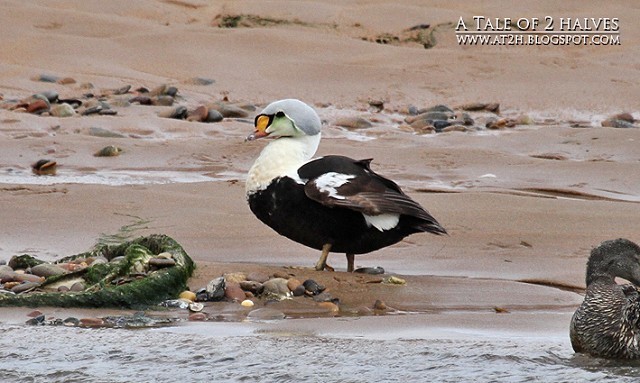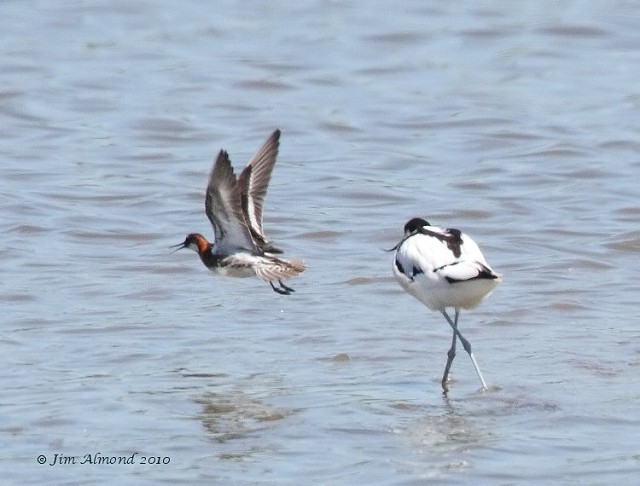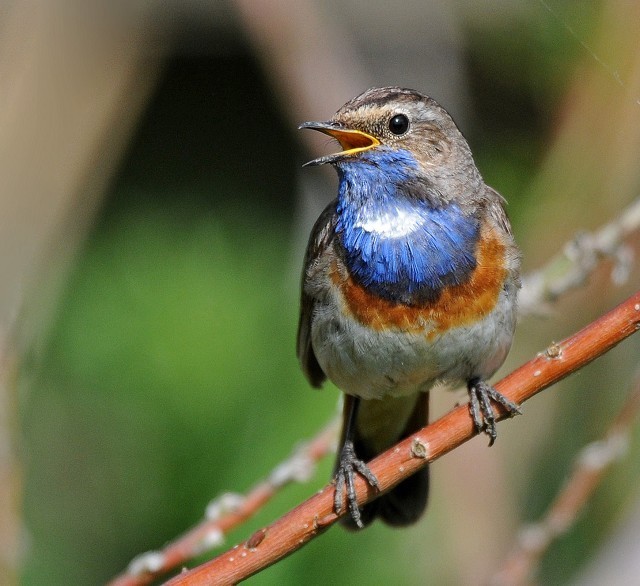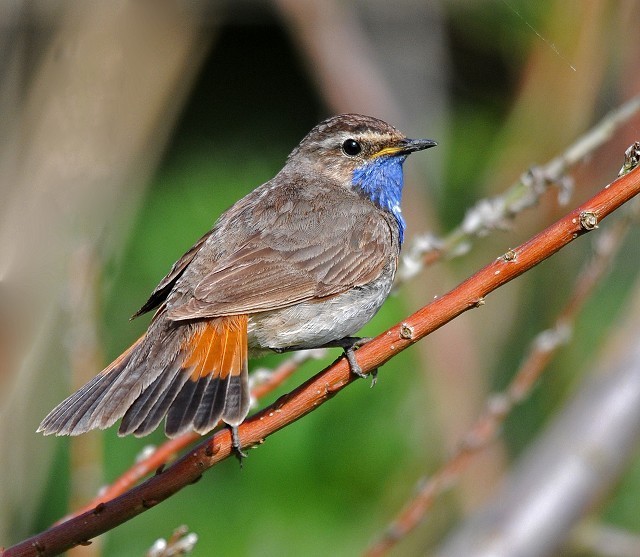- Bridled Tern in Northumberland
- Little Shearwater still in Devon
- Iberian Chiffchaffs still in Gwent and South Yorkshire
As summer progresses, as might be expected, new 'megas' are few and far between, though when they do come, they always bring with them some controversy!
Judging by the traffic on some forums, what may turn out to be one of the talking points of the year was the not-so-mysterious record of a Bridled Tern in Northumberland. OK, so the circumstances were far from simple, but that shouldn't do anything to reduce the validity of the record, though some took more convincing than others.

Bridled Tern, East Chevington NWT, Northumberland (Photo: Michael Young)

Bridled Tern, East Chevington NWT, Northumberland (Photo: Michael Young)
We received details of this bird late in the afternoon on the 23rd, simply "Bridled Tern, 1 at East Chevington" and, despite some effort in checking, no more details were forthcoming. But later that evening we received three photographs of the bird, proving beyond doubt that this was indeed the species in question. So it turns out the bird had been on the main lagoon at East Chevington for around 10 minutes at midday on 21st, roosting with Common and Sandwich Terns. This is quite typical behaviour at the site, with birds popping in and out from nearby breeding colonies (though the Bridled has yet to pop back in). As if often the way, previous reports of 'interesting terns' then surface, and this time concerned a possible Bridled or Sooty Tern past Cley on 20th, though no further details have surfaced for this record. There was also a second sighting of a dark tern by a 'tern-familiar' member of public at Budle Bay (Northumberland) on 22nd, but nothing more became of this. Interestingly, this bird comes on the back of the second record for Sweden, which was seen at Orskaren on 1st June and then from Getterön, Skåne, Sweden on 5th June.
There are fewer than 30 records of Bridled Tern in the UK, but Northumberland has always done well, with three previous records. This still remains a difficult species to catch up with, as most records are of one- or two-day birds. The last twitchable bird was a two-day bird at Rye Harbour (East Sussex) in 1993, with the last long-stayer at Cemlyn Bay (Anglesey) in 1988. The same year saw the last Northumberland bird as well, which ranged as far as Cleveland and Sands of Forvie (Aberdeenshire) during its stay.
With few new arrivals to liven things up, the only other megas that lingered included Devon's Little Shearwater, last reported singing from its burrow on Lundy in the early hours of 17th, just making it into the weekly review by 2 hours! Elsewhere, the Iberian Chiffchaffs remained singing on territory at Wentwood Forest(Gwent) to 18th and Potteric Carr (South Yorkshire) to 23rd, though still with no females to join them.
East Anglia's wandering drake Blue-winged Teal settled at Berry Fen (Cambridgeshire), remaining all week. This bird too caused some discussion when it was noted that it was ringed. The 'style' of ring apparently looked good for a wild bird, but which is more likely: a wild-ringed vagrant, or a captive-ringed escapee? If only someone could read the ring then the mystery would be solved.

Blue-winged Teal, Berry Fen, Cambridgeshire (Photo: Adam Hartley)
Fife's drake Ring-necked Duck from earlier in the month probably accounted for the record at Loch Leven (Perth & Kinross) on 21st, with the Loch also hosting a drake Lesser Scaup on 23rd, usefully in the company of a drake Scaup for comparison.
There was no mention of the Chew Valley Ferruginous Duck this week (last reported on 10th), but a drake was at Minsmere (Suffolk) on 23rd. The drake King Eider was still on the Ythan estuary (Aberdeenshire) on 17th and 18th, with 2 Little Gulls there as well. Nearby, the drake Surf Scoter made its usual Saturday appearance off Murcar (Aberdeenshire) on 19th (do you think it might be observer bias to this pattern?) with another drake in West Burra (Shetland) also on 19th.

King Eider, Ythan Estuary, Aberdeenshire (Photo: Jason Atkinson)
Odd inland sawbills are always nice and the week saw a drake Smew at Cotswold Water Park (Wiltshire) on 20th and the female Red-breasted Merganser remained at Rainham Marshes (London) on 20th–23rd.
There was a bit more interest at sea this week, with Manxies starting to stretch their wings. Peak counts were 275 past Flamborough Head (East Yorkshire) on 20th and 151 past Whitburn (Durham) on 20th. Whitburn also recorded seven Great Skuas and both Black-throated and Great Northern Diver on the weekend, with Great Skuas also past Newbiggin-by-the-Sea (Northumberland); six on 20th. Hartlepool Headland (Cleveland) also recorded both Black-throated and Great Northern Divers. Other seawatching highlights were a Balearic Shearwater off Rumps Point (Cornwall) on 17th and a Long-tailed Skua past Newbiggin-by-the-Sea (Northumberland) on 19th, though more unexpected was an inland Arctic Skua, at Ripple GPs (Worcestershire) on 20th.
Last week's report of an unidentified flamingo in East Anglia developed this week. Two birds on the main scrape at Minsmere (Suffolk) on 17th were originally thought to be Greater Flamingo but were soon reidentified as Chilean Flamingo. They later moved to Norfolk, being seen over Blakeney Harbour on the morning of 18th, then ending up at Cley for the rest of the day. They remained until 20th, though by this time people had lost interest and they weren't being reported. These birds may well originate from the self-sustaining population (of around 30 birds) in Germany/Netherlands, so may yet be tickable by some standards.
There were two records each of the storks, with White Storks reported over Wolverhampton (West Midlands) on 21st and Salisbury (Wiltshire) on 19th, and a Black Stork seen over the A1 at Haddington (Lothian) early morning on 22nd was probably the same as the 'probable' over Longniddry (Lothian) later in the day. An adult Night Heron on Benbecula (Outer Hebrides) on 22nd–23rd was a good record for the islands.
The pair of Purple Herons at Dungeness (Kent) are being seen more regularly now, visiting the nest site, so they're presumably feeding young — watch this space! The only Great White Egret was one west over Rustington (West Sussex) in the late evening of 18th; the record from Suffolk of a 'possible', seen from a train, turned out to be a rather sun-bleached plastic heron!
Having fallen off the radar for a while, a Cattle Egret over Falmer (East Sussex) on 17th was a welcome return, and the Glossy Ibis remained at Tacumshin (Co Wexford), reported on 17th and 22nd.

Glossy Ibis, Tacumshin, Wexford (Photo: Paul & Andrea Kelly)
Spoonbills continued to feature during the week, with records from all parts. The largest group was the eight that remained at Gibraltar Point (Lincolnshire) to 18th, after which five moved on to Norfolk, seen over Holme NOA at 16:20 on 18th, at Titchwell 10 minutes later, and arriving at Cley on 19th. There were also eight at Minsmere on 19th, with seven remaining to 23rd. Elsewhere, a colour-ringed bird was at Cley (Norfolk) all week, with others at Blacktoft (East Yorkshire), Elmley (Kent), Exminster Marshes (Devon), Loch of Strathbeg (Aberdeenshire), Rutland Water (Leicestershire), Samson (Isles of Scilly) and Loch Don (Argyll).
Equally widespread were lingering Ospreys, with birds at Sandy Point (Hampshire) on 17th, over the Humber from Spurn (East Yorkshire) on 18th, and at La Claire Mare (Guernsey) on 18th, Lytchett Bay (Dorset) on 20th, Tyttenhanger GP (Hertfordshire) on 22nd, Summer Leys (Northamptonshire) on 21st and Wareham (Dorset) on 22nd. There was just a single Black Kite record, of one at Castle Cary (Somerset) on 17th. Of more interest was the return of the French-ringed Montagu's Harrier, seen previously in East Anglia. It was present briefly at Collieston (Aberdeenshire) on 22nd. More details are on the BTO's 'Demog Blog'.
Red-footed Falcons continue to please, with a very obliging and photogenic adult male at Cuckmere Haven (East Sussex) on 20th–23rd. It wasn't looking too healthy when it first arrived, sitting with closed eyes for long periods. Although it perked up, maybe that's why it has been so approachable.... A first-summer male was also seen at Dungeness (Kent) briefly on 23rd, and there was also a late report of one at Baston Pits (Lincolnshire), though with no firm date attached.

Red-footed Falcon, Cuckmere Haven, East Sussex (Photo: Mickd)

Red-footed Falcon, Dungeness RSPB, Kent (Photo: Paul Kerry)
There have been a few Gyr Falcons around this year, but none have been very obliging, and a large white falcon over Marloes (Pembrokeshire) on 20th may have been this species.
On Orkney, presumably the same two Common Cranes were still present, reported on Graemsay on 18th, with one over Chester (Cheshire) on 20th and one moving down the east coast at Buckton (East Yorkshire) on 22nd.
What new birds were turning up seemed to be waders, with a White-rumped Sandpiper at Scatness (Shetland) on 20th and a Terek Sandpiper at Rogerstown Estuary (Co Dublin) on 21st–23rd both being the first of the year. The female Red-necked Phalarope remained at Frampton Marsh (Lincolnshire) to 21st and another at Upton Warren (Worcestershire) on 20th proved popular. There was also a report of a bird at Holme (Norfolk) but the details remained as elusive as the bird.

Terek Sandpiper, Rogerstown Estuary, Dublin (Photo: Paul & Andrea Kelly)

Red-necked Phalarope, Upton Warren NR, Worcestershire (Photo: Jim Almond)
The only Glaucous Gulls reported were the juvenile still off Spurn (East Yorkshire), reported on 17th, and another at Youghal (Co Cork) on 20th. The year's first Caspian Tern was at Loch Lomond (Clyde) briefly on 19th, and presumably this will have been the same bird that was then at Meikle Loch (Aberdeenshire) equally briefly on 21st, before being refound at Loch of Strathbeg, where it performed until early afternoon the same day. This is the second record for the reserve, following one seen back in August 1974.

Caspian Tern, Loch of Strathbeg RSPB, Aberdeenshire (Photo: David Parnaby)
A rather late Alpine Swift was seen with 30 Common Swifts over Whittle Dene Reservoir (Northumberland) for just five minutes on 18th, and a partial albino Common Swift ringed at the University of East Anglia, Norwich (Norfolk) on 18th might have caused a few raised eyebrows if seen distantly.

Common Swift, UEA Broad, Norfolk (Photo: Iain Barr)
A bit of summer colour came in the form of Bee-eaters at Wareham (Dorset) on 22nd, over Bruton (Somerset) on 22nd, and over Squabmoor Reservoir, Woodbury Common (Devon) on 22nd, the Hoopoe at Chertsey (Surrey), reported again on 19th after an absence of 10 days, and a Golden Oriole belatedly reported from Edenbridge (Kent) on 20th–21st, but not twitchable.
There were fewer Red-backed Shrikes this week, with a single reported from Holt Heath (Dorset) on the evening of 17th, a female at Collieston (Aberdeenshire) on 22nd, a male at Cinque Ports Golf Course (Kent) on 22nd–23rd and one on Unst (Shetland) on 22nd. The sole record of Woodchat Shrike was one reported on Bryher (Isle of Scilly) on 22nd.

Red-backed Shrike, Cinque Ports Golf Course, Kent (Photo: Steve Ray)
On the warbler front, long-stayers included the Great Reed Warbler at Straw's Bridge (Derbyshire), which remained in full song all week, and the singing male Marsh Warblers at Edderthorpe Flash (South Yorkshire) until 18th (with a nearby Garganey) and at Newchurch (Isle of Wight) to 23rd. Others were reported from the NWT visitor's centre at Cley (Norfolk) and Hauxley (Northumberland) on 18th, with a further 'possible' singing at Broadstone Reservoir (S Yorks) on 17th, though one reported at Spurn on 20th turned out to be a Reed Warbler.

Marsh Warbler, Edderthorpe Flash RSPB (Dearne Valley), South Yorkshire (Photo: Paul Thomas)
A Paddyfield Warbler in gardens at Grutness (Shetland) on 21st was the first of the year, and remarkably seven of the nine previous May/June records also came from Shetland.

Paddyfield Warbler, Grutness, Mainland, Shetland (Photo: Steve Minton)
Late news of a Rose-coloured Starling on Coll (Argyll) on 14th was followed by an adult at Brevig, Barra (Outer Hebrides) with Common Starlings on 17th.
The white-spotted Bluethroat continued to pose beautifully for photos at Welney (Norfolk) all week, and the gallery is well worth a look now. Less gaudy (and showy) was a Tawny Pipit on North Ronaldsay (Orkney) on 23rd.

Bluethroat, Welney WWT, Norfolk (Photo: Jon Evans)
At the tail end was a stunning summer male Brambling found singing Long Wood (Somerset) on 17th–22nd, as some late birds do. The only Serins seen were the male on St Agnes (Isle of Scilly) on 17th–22nd and another briefly at Gibraltar Point (Lincolnshire) on 21st.
Last, but for once not least, were a couple of Common Rosefinches. A very smart male at Glendevon (Perth and Kinross) on 17th–22nd appeared to spend a day in between times at Pool of Muckart (Forth) on 21st, with another male at Osmington Mills (Dorset) on 17th–18th. There have also been a few recent records of a calling Common Rosefinch around Weybourne (Norfolk), but considering that (bizarrely) the Kelling Weather Station is known to emit a rather rosefinch-esque noise, these must be treated with caution!

Common Rosefinch, Pool of Muckart, Forth (Photo: Willie McBay)
Photo of the Week

Whinchat, Cockmuir Bridge, Lothian (Photo:
Mike Thrower)
Other notable photos

Hawfinch, Bontddu, Gwynedd (Photo:
Keith Williams)

Bluethroat, Welney WWT, Norfolk (Photo:
Jon Evans)

White-tailed Eagle, Portree, Skye, Highland (Photo:
Ian Fulton)

Sparrowhawk, Rossall Point, Lancashire (Photo:
Jackie Moreton)

Osprey, Rothiemurchus, Highland (Photo:
Chris Upson)

Lesser Spotted Woodpecker, Bulgaria (Photo:
Mike Lane)

Long-eared Owl, undisclosed site, Lancashire (Photo:
Brian Rafferty)

Tawny Owl, undisclosed site, Cheshire (Photo:
Steve Dolan)

Black-vented Oriole, Mexico (Photo:
Gary Thoburn)

Eider, Balcomie, Fife (Photo:
John Anderson)

Red-throated Diver, Levenwick, Mainland, Shetland (Photo:
James Wood)

Curlew, Loch na Keal, Mull, Argyll (Photo:
Kev Joynes)

Linnet, undisclosed site, Norfolk (Photo:
David Whistlecraft)

Pied Wagtail, Welney WWT, Norfolk (Photo:
Rob Sewell)

Green Woodpecker, Stocker's Lake, Hertfordshire (Photo:
Tom Hines)

Short-eared Owl, North Uist, Outer Hebrides (Photo:
Peter Walkden)

Common Tern, Barton-upon-Humber Pits, Lincolnshire (Photo:
Graham Catley)

Common Buzzard, Campbeltown, Argyll (Photo:
Jimmy MacDonald.)

